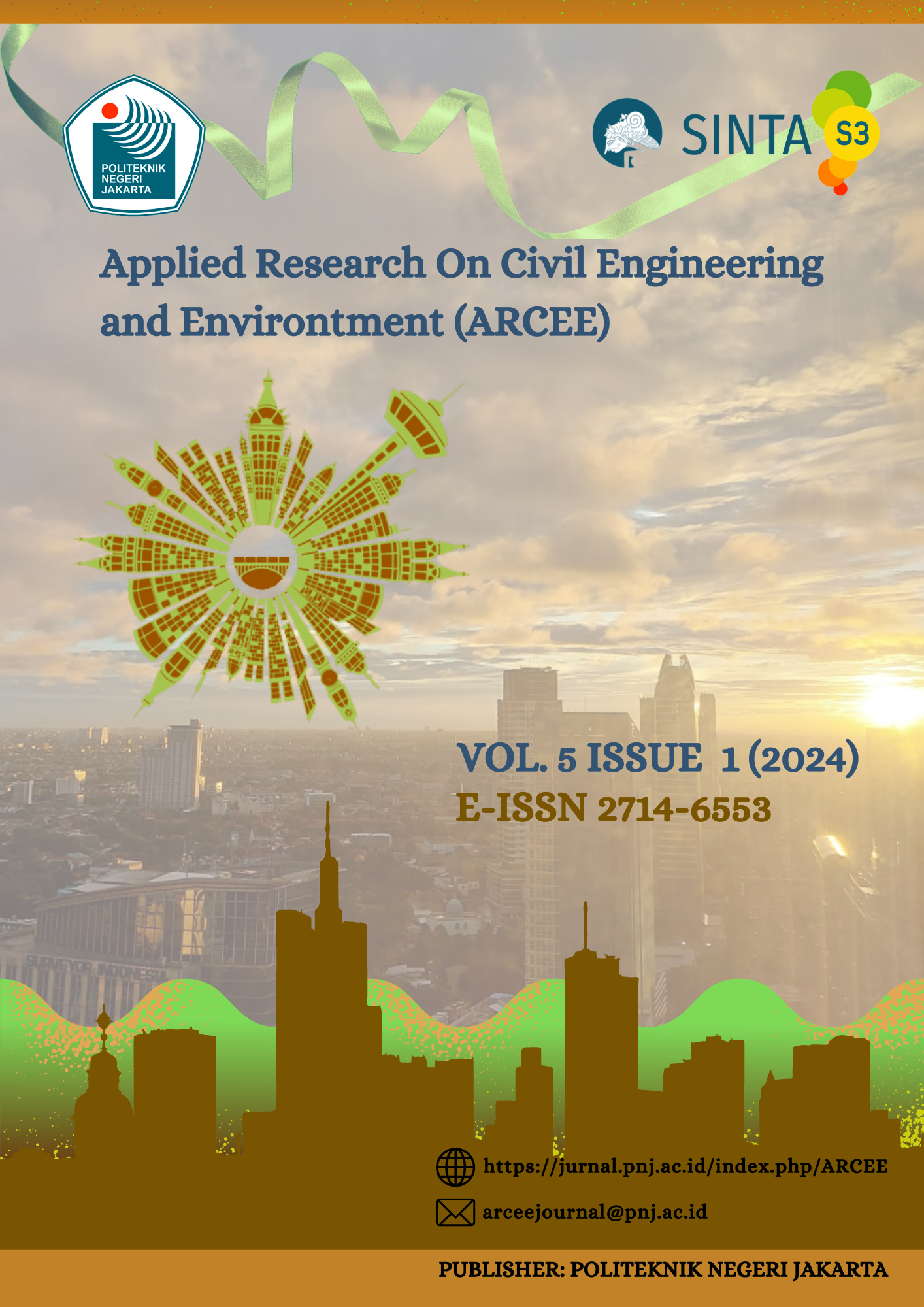ANALYSIS OF WASTE MATERIAL COEFFICIENT FOR CONCRETE CASTING WORK USING BIM CUBICOST TAS
##plugins.themes.academic_pro.article.main##
Abstract
One of the construction project activities that has a large volume of work on the upper structure is casting work. In concrete requirement planning, contractors usually multiply the book by 10%. However, in practice, the concrete requirement is still less than planned. Therefore, concrete requirement planning must be calculated accurately. The volume of concrete needs to be multiplied by the waste material coefficient. This research was conducted on the XYZ Project by directly observing to obtain the volume of realized concrete purchased so that the value of the material coefficient that has taken into account waste material will be obtained. BIM Cubicost TAS is used to minimize planning volume calculation errors. The results of this study show that for horizontal casting work, the largest percentage of residual material is 3.133%, and the average percentage of residual material for horizontal casting is 2.192%. Meanwhile, for vertical casting work, the largest percentage of remaining material is 7.219% and the average percentage of remaining vertical casting material is 3.015%. Finally, the waste material coefficient is obtained as 1.022 for horizontal casting and 1.03 for vertical casting. In the AHSP Ministerial Regulation No. 1 of 2022, the coefficient value of materials for casting work using ready-mix concrete is 1.02. This reveals that the coefficient value in AHSP Minister of Public Works and Public Housing Regulation No. 1 of 2022 has not fully calculated the real waste material in the field. The analyzed coefficient values in this study can be used as a reference for the project to determine coefficients in the AHSP and aid in planning concrete volume requirements because it already takes into account the real waste material in the field.
##plugins.themes.academic_pro.article.details##

This work is licensed under a Creative Commons Attribution-ShareAlike 4.0 International License.
References
- Allo, R. I. G., & Bhaskara, A. (2022). Waste Material Analysis With The Implementation Of Lean Construction. Jurnal Teknik Sipil, 18(2), 343-355.
- Arif, M. S., Durrotun Nasihien, R., & Sutowijoyo, H. (2021). BIM Implementation in Mall Laves Project Construction Surabaya. International Journal of Engineering, Science and Information Technology, 1(2), 13–15. https://doi.org/10.52088/ijesty.v1i2.49
- Azmi, N., Yi, T. L., Rahmat, M., Hasim, K., Choon, T. T., Hilmi, M., & Abd, I. (2023). The Application Glodon Software During Pre-Contract Stage. 3(1), 190–200.
- Baskara, F. (2022). Analisis Biaya Dan Waktu Pelaksanaan Pekerjaan Pengecoran Menggunakan Concrete Pump Dan Concrete Bucket (Studi Kasus: Proyek Pembangunan Lanjutan Gedung Perkuliahan S1 FMIPA UGM). 1–58.
- Bilqis, A. N., & Safri, S. (2023). Penggunaan Cubicost Tas Pada Perhitungan Qto Pekerjaan Pengecoran Struktur Konstruksi Gedung. In Prosiding Seminar Nasional Teknik Sipil (Vol. 5, No. 1, pp. 446-455).
- Devi, K. (2021). Analisis Dan Evaluasi Sisa Material Konstruksi Pada Proyek Pembangunan Gedung Kuliah 4 Lantai Universitas Muhammadiyah Riau. Repository Uir, 1. http://repository.uir.ac.id/id/eprint/11085%0Ahttps://repository.uir.ac.id/11085/1/153110856.pdf
- Fachlevi, S. R., Ardian, O. H., & Sari, S. N. (2023). Analisis Perbandingan Perhitungan Volume Pada Bill Of Quantity Menggunakan Software Autodesk Revit 2022 Dengan Perhitungan Manual Berdasarkan Sni 2847 Tahun 2019 Pada Gedung Serbaguna Di Desa Towangsan. StoragE: Jurnal Ilmiah Teknik dan Ilmu Komputer, 2(3), 150-164.
- Fariq, N., Ismail, S., & Ab Rani, N. I. (2022). Effective 5D Bim Requirements for Risk Mitigation During Pre-Contract Stage. Journal of Surveying, Construction & Property, 13(2017), 12–19. https://doi.org/10.22452/jscp.sp2022no1.2
- Layyinatusshifah, L., Purnomo, A., & Yasinta, R. B. (2023). Analisa Quantity Take Off Arsitektur dalam Penerapan Metode Building Modeling (BIM) Menggunakan Software Autodesk Revit 2023 Pada Pembangunan Graha Pemuda Kompleks Katedral Jakarta. Jurnal Pendidikan Tambusai, 7(3), 26300-26306.
- Hakim, Z., Purnomo, A., & Yasinta, R. B. (2023). Struktur Bangunan Gedung Menggunakan Software Bim Revit (Studi Kasus: Pembangunan Gedung Graha Pemuda Kompleks Katedral Jakarta). Jurnal Pendidikan Tambusai, 7(3), 26292-26299.
- Hendra, H., Deni, D., Karsono, B., Olivia, S., & Azhar, A. (2022). Pengenalan Peran Platform Digital Bim (Building Information Modelling) Dalam Program Autodesk Revit Bagi Masyarakat Pelajar Kota Lhokseumawe. Jurnal Solusi Masyarakat Dikara, 2(3), 166-171.
- Heryanto, S., & Subroto, G. (2020). Kajian Penerapan Builidng Information Modelling (Bim) Di Industri Jasa Konstruksi Indonesia. Architecture Innovation, 4(2), 193-212.
- Okiwijaya, N. S., & Arsyadani, R. (2019). Analisis Dan Evaluasi Waste Material Menggunakan Bim (Building Information Modeling) Pada Proyek Konstruksi (Studi Kasus Bangunan Tingkat Tinggi). Repository Unika, 1–76.
- PUPR, K. (2022). Pedoman Penyusuanan Perkiraan Biaya Pekerjaan Konstruksi Bidang Pekerjaan Umum dan Perumahan Rakyat. In Kementrian PUPR.
- Sandanayake, M., Bouras, Y., Haigh, R., & Vrcelj, Z. (2020). Current sustainable trends of using waste materials in concrete—a decade review. Sustainability, 12(22), 9622.
- Septianugraha, A. F. (2020). Estimasi Indeks Waste Material Konstruksi Untuk Proyek Bangunan Di Indonesia (Studi Kasus: Proyek Pembangunan Gedung Frc, Universitas Gadjah Mada). https://dspace.uii.ac.id/handle/123456789/36113
- Sulistio, H., & Waty, M. (2021). Kerugian Kontraktor Akibat Waste Material Proyek Konstruksi Gedung Bertingkat. PADURAKSA: Jurnal Teknik Sipil Universitas Warmadewa, 10(1), 84–98. https://doi.org/10.22225/pd.10.1.2385.84-98
- Suwarni, A., & Anondho, B. (2021). Perbandingan Perhitungan Volume Kolom Beton Antara Building Information Modeling (Bim) Dengan Metode Konvensional. JUTEKS (Jurnal Teknik Sipil), 6(2), 75-83.

